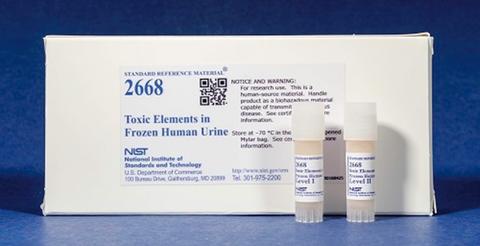Development of SRMs 2668 and 3668 for Accurate Assessment of Exposure to Toxic Elements and Anions
Summary
As part of a multi-year interagency agreement between the National Institute of Standards and Technology (NIST) and the Centers for Disease Control and Prevention (CDC), new standard reference materials (SRM) were developed in collaboration with CDC for measurements of toxic elements and anions in frozen human urine. To ensure the stability of the analytes, 28 elements and anions were prepared in two SRMs: SRM 2668 Toxic Elements in Frozen Human Urine contains 23 elements and anions (Sb, As, Ba, Be, Cd, Cr, Cs, Cl, Co, Cu, F-, K, Pb, Na, Mn, Mo, Ni, Pt, Tl, Sn, W, U, and V), and SRM 3668 Mercury, Perchlorate, and Iodide in Frozen Human Urine contains 5 elements and anions (Hg, I-, ClO4-, NO3-, and SCN-). The SRMs are intended for method validation and quality assurance in clinical measurements that assess human exposure to toxic elements and anions. Specifically, the SRMs are designed for use in the National Health and Nutrition Examination Survey (NHANES) that is conducted by CDC.
Description

SRM 2668 Toxic Elements in Frozen Human Urine
Toxic elements in the environment are a threat to public health and safety. Federal and state regulations have been issued to limit and abate the presence of toxic elements in the environment. The levels of toxic elements in the U.S. population are carefully monitored. NHANES is one of the federal programs that uses urine as a proxy to assess the exposure of the US population to toxic elements. Because sample collection is non-invasive and the test results reflect recent exposure (within two days), urine is the preferred matrix for clinical diagnostics and biomonitoring of human exposures to toxic environmental chemicals. Typically, urine samples are frozen after collection while awaiting analysis. In the past, NIST produced freeze dried SRMs for quality assurance of urine measurements, but no matter how closely freeze-dried materials resemble frozen clinical test materials, the differences between them are significant when used for quality assurance. The frozen urine matrices of the new SRMs provide better commutability with the specimens of the intended clinical measurements.
Major Accomplishments
- Produced two frozen urine SRMs, each containing two levels of analytes at 50% to 95% and >95% distribution in the US population
- SRM 3668 being the first SRM certified for the emerging environmental contaminant perchlorate
- Participation of leading clinical laboratories in the value-assign measurements securing commutability and relevance of the SRMs
- The first frozen human urine SRMs value-assigned for 28 elements and anions for clinical and biomonitoring measurements
Additional Technical Details
The new frozen urine SRMs are superior to the freeze-dried predecessors SRMs 2670a, 2671a and 2672a with respect to commutability. Moreover, the new SRMs are designed to meet the needs for measurements of emerging environmental contaminants such as perchlorate. Perchlorate can modify thyroid function by competitively inhibiting iodide uptake. The Environmental Protection Agency plans to regulate perchlorate in the environment under the Safe Drinking Water Act. SRM 3668 is the first certified reference material (CRM) to have perchlorate certified in support of regulatory guidelines to come. In addition to NIST, the certification measurements of the two SRMs were made at CDC, Mayo Clinic, and the New York State Department of Health, where clinical techniques were used to ensure relevance of SRMs for the intended applications. The development of SRMs 2668 and 3668 reflects NIST's commitment to continually improve chemical metrology to improve the health of the nation.
Associated Products
SRM 2668 Toxic Elements in Frozen Human Urine
SRM 3668 Mercury, Perchlorate, and Iodide in Frozen Human Urine

